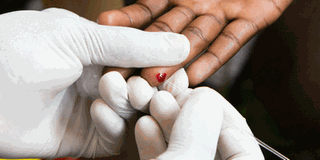Donors ask govt to focus on Aids prevention

Several people are quite hesitant towards testing for HIV/AIDS with some attributing that to high testing costs especially in poorer countries across the globe. PHOTO/COURTESY
What you need to know:
- 5.4% Prevalence: Statistics from Uganda Aids Commission indicate that HIV prevalence has declined from 6.4 percent in the previous year to 5.4 percent.
Development partners in the HIV/Aids fight have asked government to shift focus to prevention of the scourge to bring down the 730 new infections and 400 deaths registered per week.
Mr Jotham Mubangizi, the acting country representative of the Joint United Nations Programme on HIV/Aids (UNAIDS), said although Uganda has made great strides in improving testing and access to antiretroviral treatment (ART), a lot still needs to be done.
“Uganda is one of the 17 countries where access to reproductive health commodities like condoms is still low. Uganda is [also] among the few countries where mother-to-child transmission of HIV, cases of stigma and sexual violence are still high and these affect the fight,” he said.
Mr Mubangizi made the remarks at the Annual Joint Aids review and Philly Lutaaya Memorial Lecture in Kampala yesterday.
This was held under the theme “HIV & Covid: Reflecting on our Vulnerabilities and Resilience.”
Dr Nelson Musoba, the director general of Uganda AIDS Commission (UAC), said the country registered 5,300 cases of HIV infections among children last year.
He said although this is lower than the 7,000 cases reported in the previous year, it is still unacceptably high because there is medicine and clear practices to prevent it.
“Last year, we observed 38,000 new infections among adults. [At least] 5,300 were children. The annual Aids-related death is down to 22,000, which is a marked reduction but still unacceptably high because we wouldn’t want to lose anybody,” he said.
Dr Musoba said the new HIV infections are higher among adolescent girls and women.
“Out of the 38,000 new infections, you find that young people make up to 14,000 of the cases and girls who are 15-24 years are three times more likely to be infected than their male counterparts.”
Mr Mubangizi called for intentional interventions to sensitise young people, retain girls in school and address legal gaps in the fight.
Despite the worrying figures, Statistics from UAC indicates that HIV prevalence has declined from 6.4 percent in the previous year to the current 5.4 percent. On average, 90 percent of people who are infected know their status, 90 percent of those infected are enroled on ART and are virally suppressed according to UAC.
Mr Mubangizi asked the government to come clear on financing HIV/Aids fight. The biggest chunk of funds for ARVs are still coming from the government of the United States of America, according to information from UAC.
The US Ambassador to Uganda, Ms Natalie Brown, said at the event that they are supporting HIV/Aids fight because good health is a pillar for economic development and wellbeing of people. She said the US government is injecting $500 million (Shs1.7 trillion) each year to Uganda’s health sector.




